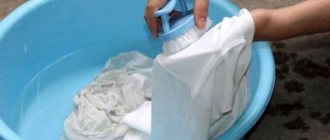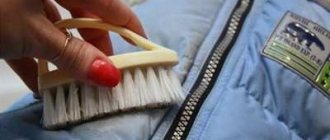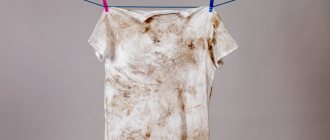How to wash a blouse so that it becomes clean and the item itself is not damaged depends on a number of factors.
Most of the models of this women's clothing are made from delicate fabrics, have a complex cut and require appropriate handling.
How to wash a blouse (white, silk, etc.) in a washing machine, what to do if the item shrinks after washing? You will find answers to these and other questions in the article.
If the item fades
If a blouse fades, then you should not wash it with other things, even of a similar shade. For such a product, the best option is a low water temperature (up to +40ºС) and the use of a high-quality detergent that works even at low temperatures.
If there is only one such blouse, you can wash it with your hands or run the machine with just one item .
An option to cope with shedding is to use special napkins when washing.
They are sent to the drum along with blouses and processed on a delicate mode. For one cycle, 3 such napkins will be enough to absorb excess paint.
Pre-soaking the item for an hour in a vinegar solution (1 tablespoon per 5 liters of water) will help prevent severe shedding of new fabric and fix the paint .
Removing stains
Removing stains from blouses is not an easy task. It is advisable to test the selected composition on an inconspicuous area before use.
Coffee
To combat the stain you will need:
- glycerol;
- ammonia;
- water.
Operating procedure:
- Measure ¼ cup of water into a container.
- Add 1 tbsp. l. glycerin.
- Add 1 tsp. ammonia.
- Stir.
- Apply the solution to the stain with a sponge, movements should go from the edges of the stain to the center.
- Leave for 10 minutes.
- Rinse.
- Wash.
Iodine
you cope with iodine stains.
- Pour ¼ cup of water into a container.
- Add 1 tsp. ammonia.
- Pour in 2 tsp. peroxide.
- Mix.
- Using a sponge, rub the stain.
- Rinse the blouse.
- Wash.
Berries
To remove stains you need to prepare:
- glycerin (5 tbsp.);
- egg yolk (1 pc.).
Description of the method:
- Mix both components.
- Apply the resulting mixture to the stain.
- Leave for a couple of hours.
- Rinse with warm water.
Fat
To remove stains from light-colored blouses, prepare the following solution:
- water (1 glass);
- ammonia (1 tbsp).
Procedure:
- Mix 2 components in a prepared container.
- Using a cotton pad, wipe the greasy stain.
- Place a piece of white cotton fabric on top of the stain.
- The affected area is ironed.
Express method for a fresh stain: treat with dishwashing detergent, leave for a quarter of an hour, then wash.
Another simple way to remove oily marks:
- Sprinkle starch onto the stain.
- Rub with a damp towel.
Pen ink
Glycerin and salt should be prepared in advance. In the process of removing stains, 2 solutions will be used.
First solution:
- pour ¼ glass of water;
- add 5 tbsp. l. glycerin;
- mix.
Second solution:
- pour 0.5 l. warm water;
- add 2 tbsp. l. salt;
- stir.
Stain removal:
- Immerse the area of the blouse with the stain in a glycerin solution.
- Leave for 2 hours.
- Dip the stained area of fabric into the saline solution.
- Leave for a quarter of an hour, moving the fabric.
- Rinse.
- Wash.
How long does it take to wash cotton 40?
So, the time for washing cotton in water at 40 degrees will be 1 hour 30 minutes. The mode will last not much longer - 1 hour 50 minutes - when heated to 60 degrees. At a temperature of 95 degrees and a spin speed of 1200 rpm, the waiting time will increase to 2 hours.
Interesting materials:
How much weight should you lose per week? How much buckwheat should you add? How much tulle do you need for a window? How much fabric do you need for curtains? How much fabric do you need for a family bedding set? How long does it take to study to become an interior designer after 11th grade? How many exercises do you need for one muscle group? How long should you cook greens? How many watts of heat are needed per 1 square meter? How much exercise do you need to do to get pumped up?
Ironing
After washing, iron natural fabrics, especially children's clothing and bedding.
Iron clothes
To make ironing easier or avoid ironing, place a few ice cubes in the washing drum. Turn on the dryer. Melted ice will have the same effect as a double boiler.
Sorting laundry
Before washing white laundry, sort the laundry by degree of soiling and type of fabric. Place lightly soiled natural fabrics on one side and items that are difficult to dry on the other. Synthetic materials, wool and silk are also sorted.
When washing white laundry, sort it first
Load lightly soiled items into the machine and wash them in the appropriate program. Heavily soiled clothing should be pre-washed and contaminated areas should be treated on site.
How to choose the right program
Many housewives are lost when choosing a suitable program. Experts advise choosing depending on the type of fabric. Are you struggling to keep your cotton clothes white? The cotton program is the best solution. For synthetic clothing, the “synthetic” mode is suitable.
When washing items whose composition is questionable, use the “synthetic” or “delicate wash” mode.
Don't forget to set the desired temperature and spin level. Avoid intensive ironing - it spoils particularly “delicate” fabrics and can make further ironing difficult, severely crumpling things.
At what temperature should I wash?
Let's take a closer look at the temperature regime. When choosing the optimal one, consider the minimum acceptable.
For example, in a pile of sorted clothes there are things that can be cleaned at a temperature no higher than 40 degrees. Other products tolerate 60 degrees well. When setting the temperature, select the minimum temperature of these values - 40 degrees.
Cotton without synthetic impurities is even allowed to be boiled. Almost all machines have a temperature maximum of 90-95 degrees. Want perfect whiteness? Feel free to choose intensive heat treatment.
Flax is more “capricious” and does not tolerate temperatures above 40 degrees.
Hand washing rules
Washing blouses by hand is preferable to machine washing, especially when it comes to thin translucent chiffon blouses or delicate silk ones.
Washing procedure:
- The blouse is inspected for damage. If there are any, defects should be eliminated before washing.
Warm water is poured into the basin.- Dilute the detergent.
- They dip the thing.
- For a better washing effect, the blouse can be soaked for a short time for about 30 minutes.
- The item is washed carefully.
- Rinse.
- Squeeze effortlessly. For delicate fabrics, spinning should be done by wrapping the blouse in a terry towel.
- Sent out to dry.
Fabric type: what does it affect?
Women's blouses are made from a variety of materials. Each type should have its own approach.
Chiffon
Feminine, weightless and very beautiful chiffon items are recommended to be washed only by hand. The water temperature for such products should not exceed +30ºС.
Regular washing powders are not suitable for such blouses; you must use only products that are intended for delicate fabrics .
Due to the fact that chiffon is a very delicate fabric, it should be washed effortlessly, and only be washed after wrapping it in a terry towel.
You cannot wring out the blouse too much, let alone twist it - the material will not withstand such a test.
Silk
Natural silk is one of the delicate materials that requires care. The following recommendations must be followed:
for washing, choose a gel rather than a powder detergent;- no need to take the item to dry cleaning;
- Do not use bleach, especially with chlorine;
- ironing at low temperature immediately after washing;
- The blouse can be washed at low temperatures – up to +40ºС;
- spin – very carefully, without twisting – it’s better to just let things drain.
Rayon is processed like a synthetic.
Synthetics
A synthetic blouse may lose its shape if not washed correctly. To prevent fabric damage, remember that:
- spin must be set to minimum;
- wash the blouse only after fastening all the buttons, zippers, Velcro and snaps;
- turning inside out is a mandatory ritual;
- the use of stain removers should be limited.
It is advisable to use liquid detergents, as powders can leave unsightly stains on the fabric.
Cotton
A blouse made of cotton fabric is practical and pleasant to the body. It is not difficult to wash it if you follow these recommendations:
- do not tumble dry;
- use stain removers and bleaches with caution;
- spin – up to 800.
Read about how to wash cotton here.
What to do if the fabric shrinks?
Deformation of the item, in particular shrinkage, may be the result of improper washing or drying. It is not possible to correct the defect in all situations.
If a blouse made of synthetics has shrunk, you can try to restore its appearance in the following way:
Soak the product in cold water.- Leave for a quarter of an hour.
- Load into washing machine.
- Select “delicate wash” in the settings, spin – 400, water temperature – 30.
- Start the wash.
- No powder is added.
A shrunken item made of cotton or mixed fabric can be restored as follows:
- soak in cold water for 15-20 minutes;
- shake off;
- lay out on a horizontal plane, pulling the blouse with your hands so that it regains its shape.
Proper drying
After the blouse is washed, it should be dried. It is convenient to do this by hanging it on a hanger. Even if the fabric is wet, it will drain.
It is also possible to dry blouses laid out on a horizontal plane. Blouses are dried on a dryer so that the item does not touch other clothes.
If the street is chosen for drying, then direct sunlight should be avoided . In the room you need to choose a suitable place for drying:
- dry,
- warm,
- with good air access.
You should not try to speed up the process by hanging shirts on radiators or near a fire. While the blouse is still wet, the product should be well straightened to avoid creases.
Features for different color
If several items are sent for washing, and blouses are among them, then the whole pile needs to be sorted. Blouses differ from each other not only in the type and density of the material, but also in color:
Pure white blouses must be washed separately, using detergent for white items. They will emphasize the whiteness and help preserve the color, since they contain bleaching components.- To process black fabrics, you also need a powder or gel designed for products of this particular shade. It will prevent color loss.
- For other colors, any universal powder or gel will do. If necessary, it can also be used to process both black and white blouses, but this is not advisable.











